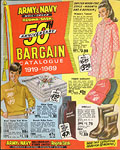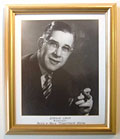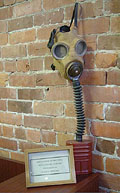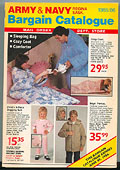|
|
| |
 |
|
| |
 Army
and Navy 50th Anniversary Bargain Catalogue, 1919-69, cover. Army
and Navy 50th Anniversary Bargain Catalogue, 1919-69, cover.
|
|
| |
|
|
|
Army and Navy's mail-order catalogue operations
ran
from 1925-86, making it one of the longest running Canadian
department
store catalogues. "Canada's Original Discount Store,"
Army
and Navy's low-end retailing approach was unique with a focus on
distress
merchandising: bankruptcy sales, cash purchases, and discount goods.
Although
the catalogues days are over, the company still has six department store
locations
in British Columbia and Alberta.
Discount Shopping during the
Depression
| The Second World War and Its Aftermath | Department
Store Expansion | The End of the Mail-order
Business |
Acknowledgements | Further
Reading
|
| |
 |
|
| |
 Portrait
of Samuel Cohen. Portrait
of Samuel Cohen.
|
|
| |
|
|
|
Born in San Francisco in 1897, Samuel Joseph Cohen opened his first
Army and
Navy store on West Hastings Street in Vancouver in 1919, selling
liquidation
stock, and First World War army-and-navy surplus goods. For many years,
Army
and Navy purchased its stock from closing, bankrupt, or destroyed (fire
and flood)
stores. The company's philosophy was to buy goods at the cheapest
prices
possible and pass the savings on to customers and to buy and sell in
volume for
cash.
| |
 |
|
| |
 First
World War gas mask, first supplies of surplus goods sold by Army and
Navy. First
World War gas mask, first supplies of surplus goods sold by Army and
Navy.
|
|
| |
|
|
|
Cohen opened a second store in Regina in the 1800 block of Scarth
Street in
1920 and, in 1925, the mail-order headquarters. The first Army and Navy
store
in Edmonton opened in 1928, north of Jasper Avenue on the west side of 101
Street.
Cohen's brothers, Joseph Cohen of Vancouver and Harry Cohen from
Edmonton,
joined him in the business.
| |
 |
|
| |
 The
original Army and Navy store in Edmonton. The
original Army and Navy store in Edmonton.
|
|
| |
|
|
|
The Army and Navy catalogue extended the reach of the department stores
into
the rural heart of the prairies. In the late 1920s, the Regina
store's
advertisement in "The Farm Movement," encouraged readers to
watch
for the new catalogue and to use the slogan: "Your money's
worth
and more — or your money refunded." It advertised that the
mail-order
department was "equipped to give 12 hour service on all
orders."
| |
 |
|
| |
 Mail-order
coupon. Mail-order
coupon.
|
|
| |
|
|
|
Running from 40 to 80 pages, Army and Navy's catalogues were
small relative
to Eaton's and Simpson's, but they were filled with bargains.
Army
and Navy was not a full-line department store: The catalogues featured
primarily
clothing, hardware, hunting and fishing supplies, some toys, and household
goods.
Stock varied considerably from one catalogue to another because of the way
goods
were purchased. Catalogue pages were relatively small at 8" x
10"
and colour was limited, making it an inexpensive catalogue to produce.
Along
with the orders, Army and Navy sent customers mail-order coupons that
could be
applied to their next purchase. It was also possible to purchase gift
certificates
for use through mail order. Goods not sold through the catalogues were
sometimes
cleared out through the store.
|
Discount Shopping during the Depression
The Depression of the 1930s provided opportunities for Army and Navy
to purchase
stock of bankrupt manufacturers and department stores for sale through its
department
stores and catalogue. The store in Moose Jaw, Saskatchewan, opened in
1933. The
catalogue began to be called "The Bargain Book of a Nation."
The
spring-and-summer catalogue of 1936 stated: "[W]e are very happy to
know
that by offering better merchandise at Canada's lowest prices we
will to
some extent help the thousands of people who must 'stretch'
their
dollars this fall and winter as never before — this is the first
Mail-order
house in the history of the Mail-order business to offer its customers the
advantages
in 'price' and 'quality' made possible by the
purchase
of hundreds of Bankrupt stocks, Distress merchandise and factory surpluses
…"
Cohen was sensitive to the situation of prairie farmers and their need
for
practical, inexpensive goods. On retiring as manager of the Regina store,
Cec
Keiser was quoted in The Leader-Post, April 30, 1977:
"Sammy was
always concerned with the poor people and many of our customers in the
1930s
were farm families and those on relief."
| |
 |
|
| |
 "Canada's
Lowest Prices" from the Army and Navy Spring/Summer Catalogue, 1936,
p. 3. "Canada's
Lowest Prices" from the Army and Navy Spring/Summer Catalogue, 1936,
p. 3.
|
|
| |
|
|
|
The 15th anniversary fall-and-winter catalogue of 1937-38 noted:
"Owing
to the failure of crops in a large portion of our Mail-Order territory we
have
repriced downward practically this entire Catalogue in order to unload
huge stocks
of New Fall and Winter Merchandise, regardless of greatly advanced prices
everywhere."
Keiser noted that much of their daily take in the 1930s was government
relief
cheques. Cec recalls that it wasn't uncommon to have a farm family
arrive
and spend its entire cheque in the store. "Yes, and many times we
would
take a family across to a nearby café and buy them dinner before
they
headed home at night. It was almost an everyday thing."
The 1938-39 fall-and-winter catalogue, promoted as a
Manufacturers Liquidation
Sale, noted: "The industrial recession that set in over a year ago,
bringing
prices down, caused manufacturers stocks to pile up and orders have gone
out
to liquidate — sell out and get the cash …"
|
The Second World War and Its Aftermath
The New Westminster, BC, store opened in 1939, making Army and Navy
one of
the largest department store chains in Western Canada, with branches in
Regina,
Moose Jaw, Edmonton (two), Vancouver, and New Westminster. Each store was
responsible
for its own buying. During the Second World War, Army and Navy was the
first
store in Western Canada to introduce self-serve shoe departments, with
tables
dedicated to individual sizes. The retailer became famous for its shoe
sales,
for which people would line up around an entire city block. Following the
war,
Army and Navy again carried army surplus goods.
By 1950, more than 400 000 catalogues were being distributed throughout
Canada.
In the 1960s, to save printing costs Army and Navy produced an annual
catalogue,
"The Nation's 12 Month Bargain Book," rather than two
seasonal
catalogues. Periodically, extra catalogue pages were added to promote
particular
bargains.
|
Department Store Expansion
| |
 |
|
| |
 Army
and Navy 50th Anniversary Bargain Catalogue, 1919-69, cover. Army
and Navy 50th Anniversary Bargain Catalogue, 1919-69, cover.
|
|
| |
|
|
|
In December 1966, Samuel Cohen died and Garth C. Kennedy became
president
with Jack D. Cohen, vice-president. The company grew. Edmonton's
north
side store, located at 97th Street and 103rd Avenue since 1955, was
extensively
renovated and enlarged. The second floor, previously used for storage, was
converted
to sales in the fall of 1968. At the time, the company employed over 500
people
in Edmonton.
| |
 |
|
| |
 Bargain
Roundup, Army and Navy Sale Catalogue, Spring 1978, cover. Bargain
Roundup, Army and Navy Sale Catalogue, Spring 1978, cover.
|
|
| |
|
|
|
In 1969, Army and Navy doubled the floor space of the Regina store (now
in
its fifth location). In 1973, "Canada's Original Discount
Store,"
opened a store in a former Eaton's location in Saskatoon at 21st
Street
and 3rd Avenue. The New Westminster store moved to a new location at 502
Columbia
Street in 1978. In 1980, encouraged by the boom taking place in Calgary,
Army
and Navy opened the chain's eighth link at 1107 33rd Street NE. The
Calgary
store marked a departure in several ways. It was the first store built by
the
company, rather than a refurbishment. The store was located in a new kind
of
location in a shopping centre serving a blue-collar clientele, rather than
in
a downtown area.
Shopping at an Army and Navy store was a treat for bargain hunters from
all
walks of life, particularly at the $6.95 shoe sales. A number of monikers,
such
as Antoine's, the Army and Navy Boutique and, in Regina, "The
Little
Shop on 11th Avenue," were introduced by middle-class customers to
disguise
the fact they shopped at a discount store.
|
The End of the Mail-order Business
| |
 |
|
| |
 Cover
of the last catalogue: Army and Navy Fall/Winter Bargain Catalogue,
1985-86. Cover
of the last catalogue: Army and Navy Fall/Winter Bargain Catalogue,
1985-86.
|
|
| |
|
|
|
The Army and Navy "Bargain Catalogue" of the mail-order
department
store continued to be published out of Regina until 1985. The
Leader-Post
indicated that the company decided to cease publication because the
rural
population was smaller (circulation had dropped to 100 000) and they
were
more mobile than in the early years; at the same time, postal service had
declined
and costs had increased. In 1998, CEO Garth Kennedy died and management of
the
company passed to Samuel's granddaughter Jacqui Cohen. The head
office
moved from Regina to Vancouver. The Moose Jaw store closed in 2000,
followed
by the other two Saskatchewan stores. The mail-order business is no more,
although
business is still brisk at the department stores. Two new stores were
recently
opened in Langley, BC, in 2001, and the newest store, in Edmonton's
Londonderry
Mall in November 2003.
|
|
Acknowledgements
Thanks to president Jacqui Cohen and Army and Navy staff including the
late
Harry Singh, Kari Logue, and Gerry Loughran for their assistance while
conducting
the research and obtaining images for this text.
Further Reading
Little research has been done on the history of Army and Navy. The
corporate
archives, consisting of catalogues, newspaper clippings, photographs,
financial
records, etc. are held at the Vancouver store.
|
| |
|
|